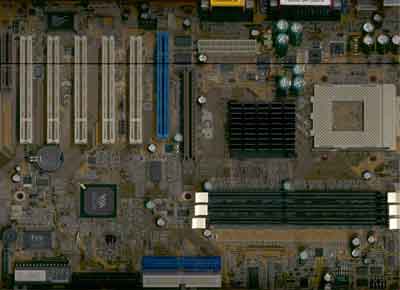VIA KT266A Motherboard Roundup - January 2002
by Mike Andrawes on January 18, 2002 4:48 AM EST- Posted in
- Motherboards
Chaintech CT-7VJDA
|
Chaintech CT-7VJDA |
|
|
CPU
Interface
|
Socket-A
|
|
Chipset
|
VT8366A
North Bridge
VT8233 South Bridge |
|
Form
Factor
|
ATX
|
|
Bus
Speeds
|
100
- 166MHz (in 1MHz increments)
|
|
Core
Voltages Supported
|
+0.025
- +0.350 V (in 0.025V increments)
|
|
I/O
Voltages Supported
|
Not
Configurable
|
|
DRAM
Voltages Supported
|
Not
Configurable
|
|
Memory
Slots
|
3
184-pin DDR DIMM Slots
|
|
Expansion
Slots
|
1
AGP Slot
5 PCI Slots 1 ACR Slot 1 CNR Slot |
|
Onboard
RAID
|
N/A
|
|
Onboard
USB 2.0/IEEE-1394
|
N/A
|
|
Onboard
Audio
|
C-Media
CMI 8738
|
Just like their AMD 760 solution, the Chaintech CT-7VJDA comes with a large size heatsink on the North Bridge, rather than a much smaller HSF unit. While we are not sure about the reason behind this, one possibility is to cut down the cost of manufacturing the board. You can easily find the board selling for less than 90 dollars in the market, which is very attractive.
The board has a total of 3 DIMM slots, something very common among all KT266A boards. While the CT-7VJDA doesn't offer any voltage tweakings for I/O or memory, the CPU core voltage could be increased by as much as 0.350V, which could be substantially higher than the default voltage. This could be good news for hardcore overclocking, but at the same time extensively cooling has to be done to avoid damaging the CPU.
There is a jumper on the board separating the 100/133MHz FSB range, which makes overclocking a bit of trouble when going over the boundary. Same thing goes for the chip multiplier ratio setup, which is done through a set of 4 dipswitches instead of inside the BIOS.
The CT-7VJDA also uses the C-Media CMI8737 PCI sound chip for better audio capabilities. The ACR and CNR slots on the board make it a good candidate for the OEM market but it's definitely not as useful for end users like us. We would rather see the ACR slot replaced by another PCI slot.
The board was mostly stable throughout our tests although we did encounter some small lockups during the Content Creation Winstone 2002. The CT-7VJDA might not be the best board for overclocking out there, but it could still be a very good candidate for Duron users.











3 Comments
View All Comments
Anonymous User - Monday, September 29, 2003 - link
How do I get my Engine to Memory clock to run synchronous for my Epox 8kha+ boardxrror - Saturday, August 14, 2021 - link
This was such an exciting time in PC hardware. Intel was still trying to cram Rambus down the industry's throat - and obstinately trying to strong arm the mobo makers and force chipset makers to Rambus licensing. We still had VIA, SiS, ULi, and even nVidia in the chipset market, and with AMD's Athlon line still extraordinarily competitive and Intel in full attack they could no longer just consider AMD as a side-show - this was their leverage against Intel and they had to treat Socket A as premium platform.NegativeROG - Wednesday, June 15, 2022 - link
I still have this board. AND, I invested all of a $10,000 inheritance in Rambus RDRAM. I'm smarter now (I hope). But, you are right about exciting times in the PC space. I navigated away from AMD for a bit, but came back, and will stay forever. Team RED!